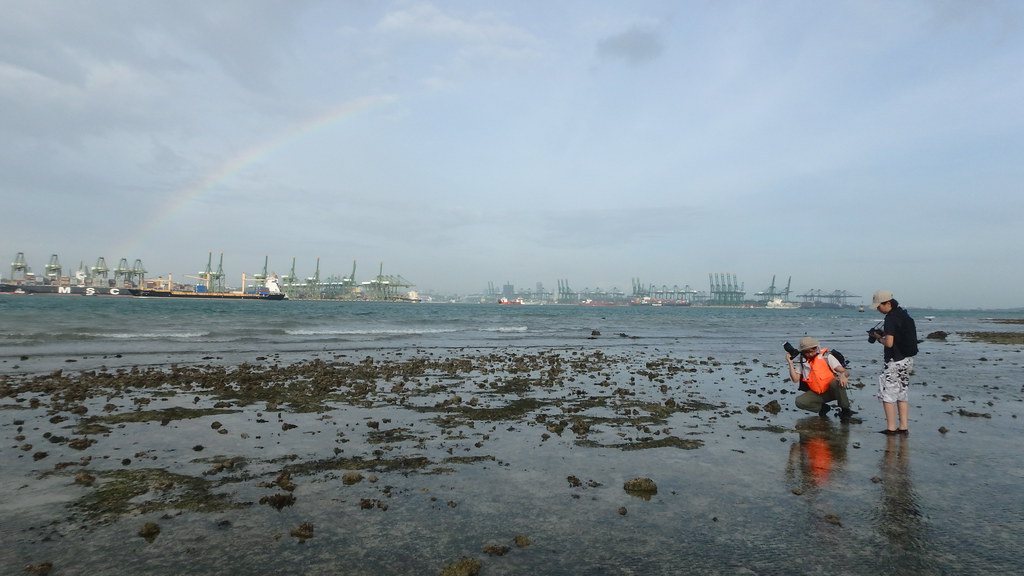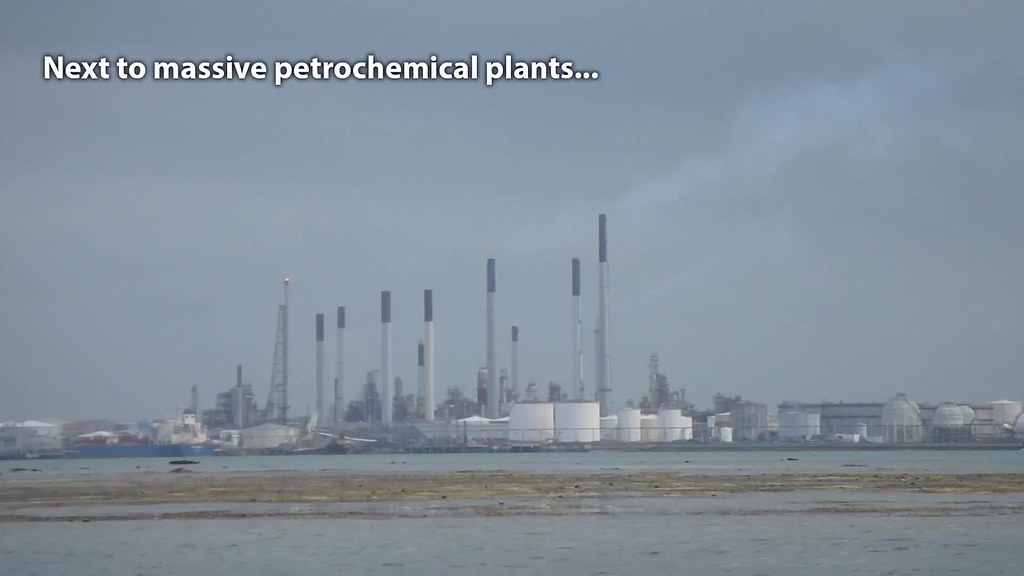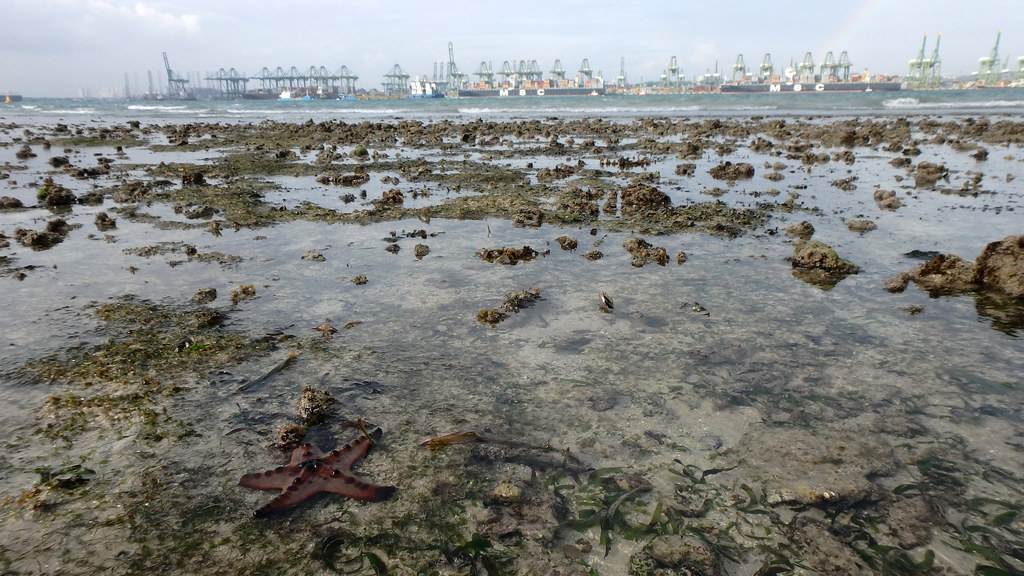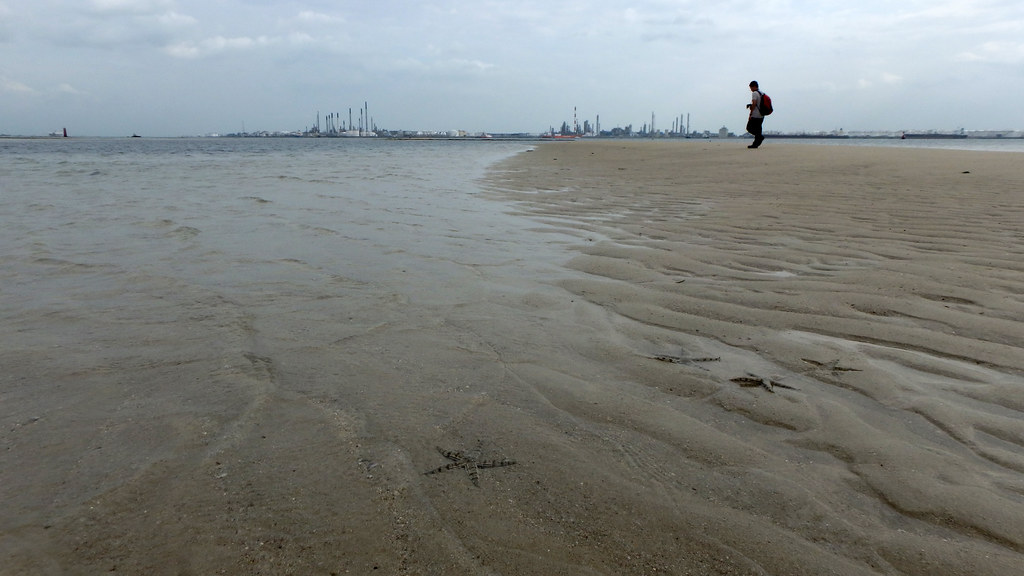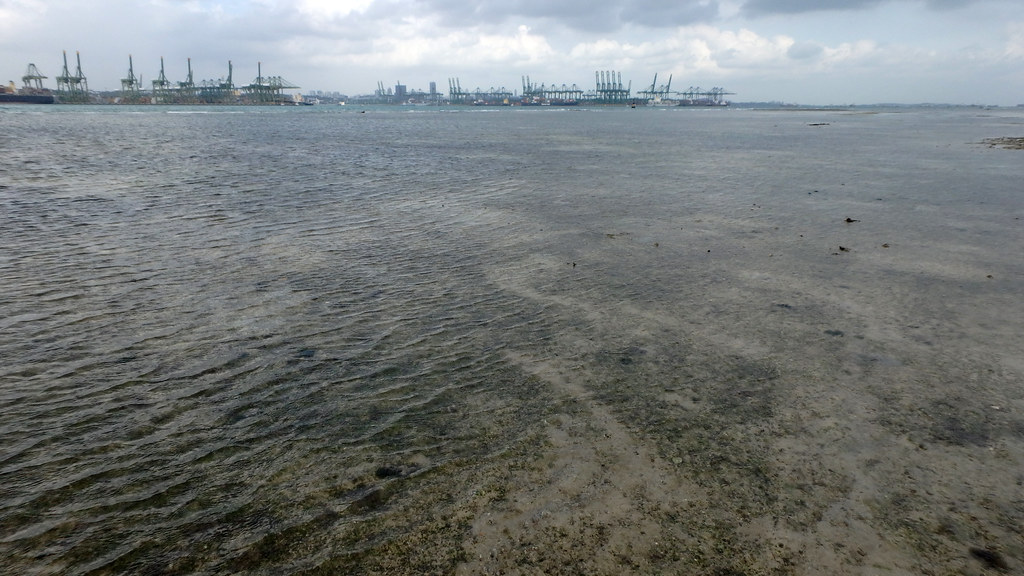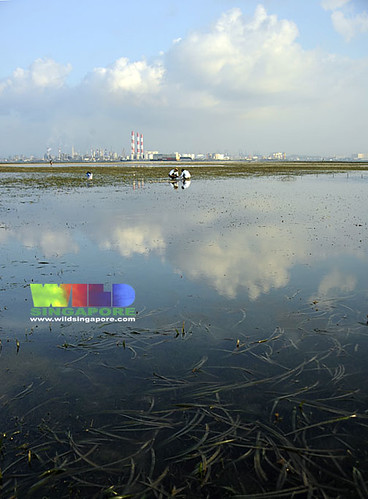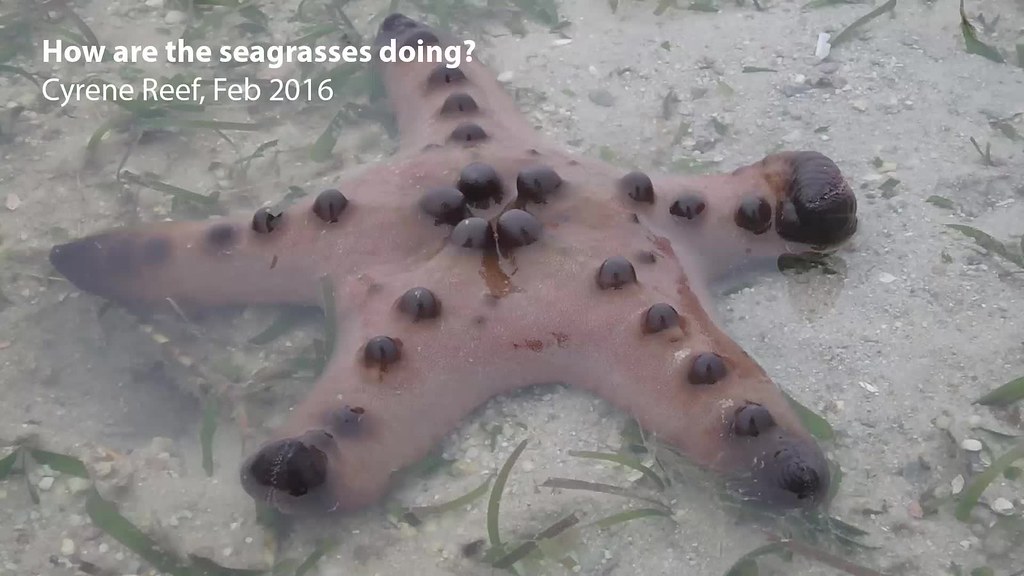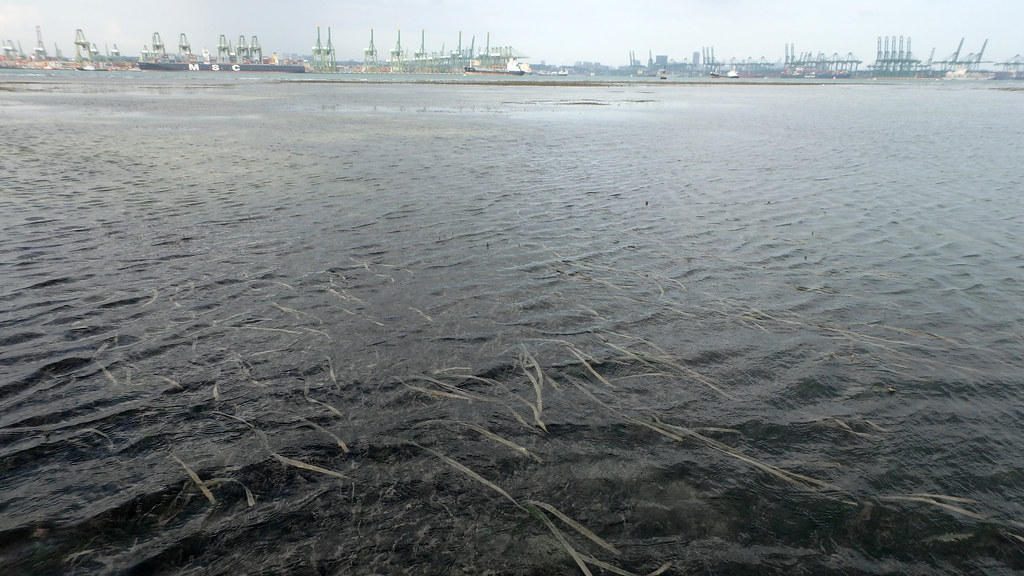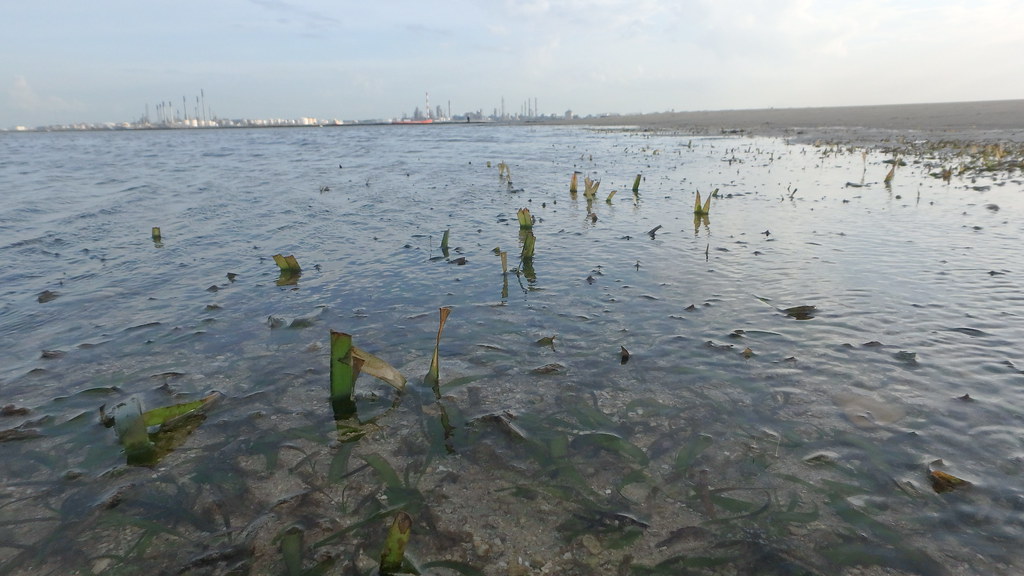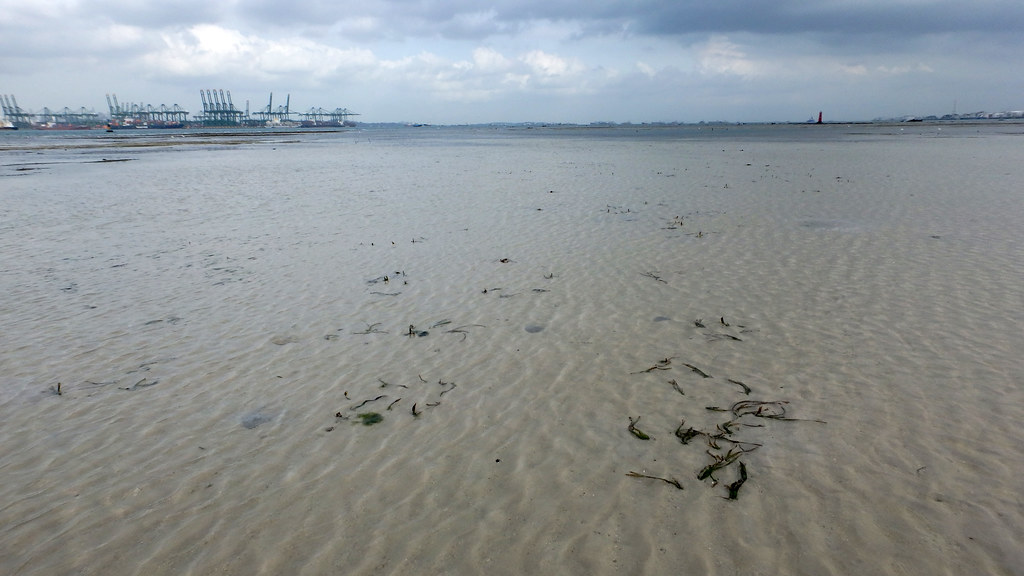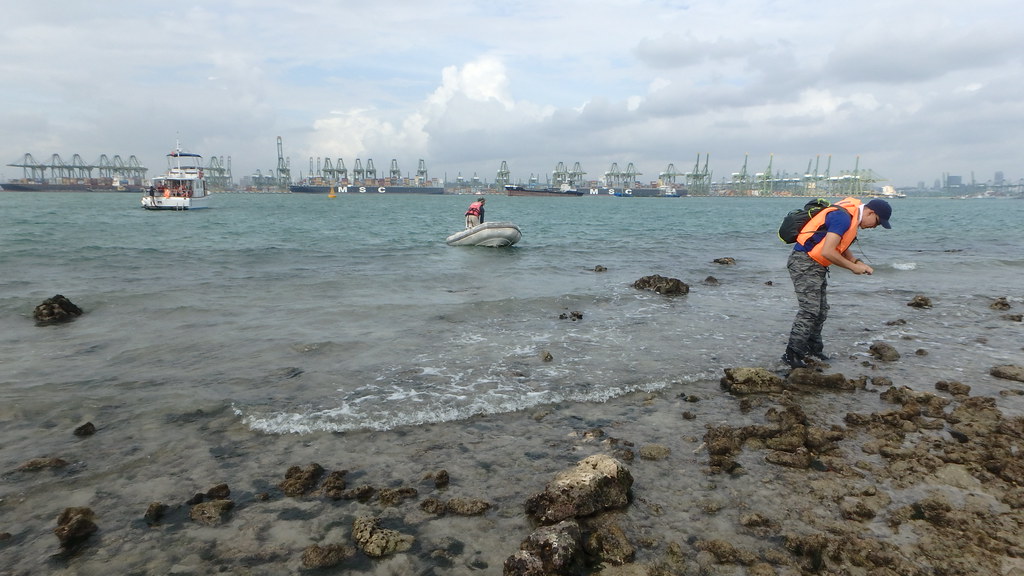It was great to see the seagrasses coming back in the deep pool. But worrying that none of us saw the mass gathering of large Knobbly sea stars that Cyrene is well known for.
Cyrene lies in the middle of the industrial triangle made up of the massive industries on Jurong Island, huge refineries on Pulau Bukom and the world-class container terminals at Pasir Panjang.
Despite its location, Cyrene has lush seagrass meadows teeming with life! Today, I decided to check on seagrasses on the eastern side of this large submerged reef. The last time I checked here was one year ago in Feb 2016. (Because mass coral bleaching meant I focused on the western side on subsequent trips). Here's a video clip of some life among the seagrasses: large carpet anemones and large snails such as the Noble volute and Grey bonnet snail.
I so wanted to show the first-timers to Cyrene the large numbers of Knobbly sea stars that we usually see there. But alas, we couldn't find the Knobbly sea star party. Each of us saw only 1-2 Knobbly sea stars. I do hope the sea stars (which can live for decades) are alright and perhaps now in deeper waters?
The Common sea stars were still abundant!
How are seagrasses in the deep pool doing?
There is a deep pool on Cyrene that used to be lush with seagrasses. In 2010, the seagrasses drastically declined (together with general loss all over Cyrene) and the pool turned into a sandy one with hardly any seagrass. Here's a look at the deep pool over the years, at its best and its sudden death.
This is what the pool looked like in Jun 2009, with Jeff and Collin of NParks doing a survey of the abundant variety of fishesfound in the pool.
Aug 2010: The pool is still full of lush long Tape seagrass. In this photo, an NPark's team is gently doing a survey of the fishes that are found in the pool. More in this blog post.
May 2010: NParks continued their fish survey and found many different kinds here.
 Nov 2010: The seagrasses at Cyrene were not doing well at all! Most of the Tape seagrass blades (Enhalus acoroides) were broken off very close to the sand surface. In the lagoon where NParks does their survey of pipefishes, there is virtually no more seagrasses. Previously the lagoon was thick with Tape seagrasses.
Nov 2010: The seagrasses at Cyrene were not doing well at all! Most of the Tape seagrass blades (Enhalus acoroides) were broken off very close to the sand surface. In the lagoon where NParks does their survey of pipefishes, there is virtually no more seagrasses. Previously the lagoon was thick with Tape seagrasses.
May 2012: It turned into a rather clear pool with the white sandy base showing, and no long Tape seagrasses. Although the Tape seagrasses are still there (but short) and there are some other kinds of seagrasses growing at the bottom, and especially at the shallower edges.
Mar 2012: The big pool which used to be full of long lush Tape seagrass remains bare of Tape seagrasses. But other seagrass species are growing on the sandy bottom.
Aug 2012: There are still lots of seagrasses at the edges of the pool. But in the deeper part of pool, it's very bare of seagrasses. Tape seagrasses here are still cropped short, with not much of other kinds of seagrasses.
Apr 2013: We checked the pool in the middle of the Reef and it's still rather bare. Although there are other kinds of seagrasses especially around the shallower edges, the Tape seagrasses here are still very short, even in deeper parts of the pool.
Aug 2015: Finally, five years later, on this trip I was so relieved to see much more seagrasses growing in the deep pool.
 Feb 2016: Here's a video of what I saw in the pool a year ago.
Feb 2016: Here's a video of what I saw in the pool a year ago.
Feb 2017: Today, I saw long Tape seagrasses growing from lush meadows of other seagrass species which are shorter. It looks almost like it used to in 2010.
There were many Forskal's sidegill slugs on the shore today. They got their name because they have one plume-like gill on one side of the body. I saw also some egg ribbons that look like they were laid by the slugs.
Cyrene is the only southern shore with an abundance of echinoderms. White sea urchins remain abundant. Kok Sheng found one Thorny sea urchin. But we didn't see any living Cake sand dollars which are usually so abundant in the sandy areas.
Also sea cucumbers: with many Long black sea cucumbers. I saw one Garlic bread sea cucumber and one Brown sea cucumber and one Remarkable sea cucumber in the sand.Cyrene is the only southern shore with an abundance of echinoderms. White sea urchins remain abundant. Kok Sheng found one Thorny sea urchin. But we didn't see any living Cake sand dollars which are usually so abundant in the sandy areas.
There were not many sea anemones and friends but none of them were bleaching. I saw a few Haddon's carpet anemones, one Snaky anemone, a patch of many Banded bead anemones. The cerianthid is not a true anemone, I saw a few of them. There are not many corals in this survey area and those I saw were not bleaching.
I also saw a young mosaic crab (highly poisonous) and egg ribbons of nudibranchs.
Dugongs only eat seagrasses and so we keep a lookout for their feeding trails in seagrass meadows. Today, we saw some feeding trails at Cyrene Reef!I also saw a young mosaic crab (highly poisonous) and egg ribbons of nudibranchs.
How are seagrasses in the deep pool doing?
There is a deep pool on Cyrene that used to be lush with seagrasses. In 2010, the seagrasses drastically declined (together with general loss all over Cyrene) and the pool turned into a sandy one with hardly any seagrass. Here's a look at the deep pool over the years, at its best and its sudden death.
This is what the pool looked like in Jun 2009, with Jeff and Collin of NParks doing a survey of the abundant variety of fishesfound in the pool.
Aug 2010: The pool is still full of lush long Tape seagrass. In this photo, an NPark's team is gently doing a survey of the fishes that are found in the pool. More in this blog post.
May 2010: NParks continued their fish survey and found many different kinds here.

May 2012: It turned into a rather clear pool with the white sandy base showing, and no long Tape seagrasses. Although the Tape seagrasses are still there (but short) and there are some other kinds of seagrasses growing at the bottom, and especially at the shallower edges.
Mar 2012: The big pool which used to be full of long lush Tape seagrass remains bare of Tape seagrasses. But other seagrass species are growing on the sandy bottom.
Aug 2012: There are still lots of seagrasses at the edges of the pool. But in the deeper part of pool, it's very bare of seagrasses. Tape seagrasses here are still cropped short, with not much of other kinds of seagrasses.
Apr 2013: We checked the pool in the middle of the Reef and it's still rather bare. Although there are other kinds of seagrasses especially around the shallower edges, the Tape seagrasses here are still very short, even in deeper parts of the pool.
Aug 2015: Finally, five years later, on this trip I was so relieved to see much more seagrasses growing in the deep pool.

Here's a video of the deep pool today.
Along the way, I saw Tape seagrasses of various lengths. Some long leaf blades were transparent.
In many places the Tape seagrass are still cropped.
There seems to be a larger patch of bare sand in the middle of Cyrene near the deep pool.
It's great to see the seagrasses recovering at Cyrene. And we can only hope that this amazing shore continues to remain alive and kicking.
Thanks as always to Alex and his crew for bringing us safely there and back!
Photos by others on this trip
- Marcus Ng on facebook.
- Debby Ng on the Hantu Blog.
- Loh Kok Sheng on his blog.
Others on this trip: Russel Low, Mr Kuet, Mei Lin, Lynette.
On 20 Mar 2017 Ywee Chieh shared photos of a dive at Cyrene which included some sightings of a bleaching anemone and some pale corals.

